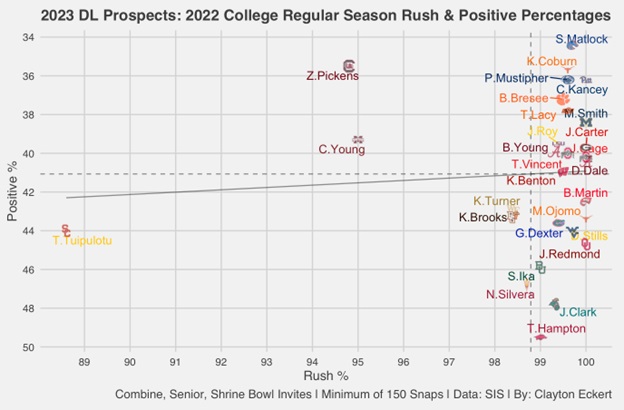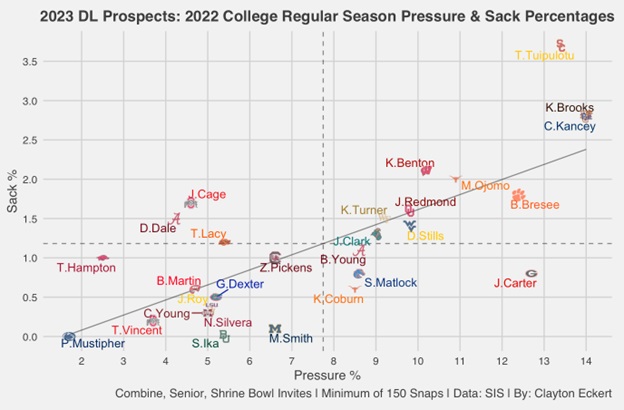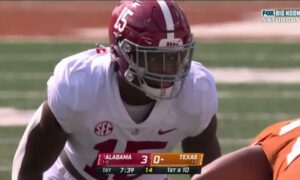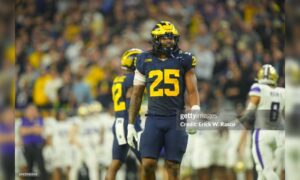Today I wanted to look at some pass rushing numbers for defensive lineman in the upcoming 2023 NFL Draft. Couple notes before we dive in. First, the players we view today were invited to the combine, and/or the Senior or Shrine Bowl games. Second, the player needed a minimum of 150 total snaps to make the list for today. Also, there may be disagreements/names missing depending on personal opinions, and my list took size and/or substantial snaps played at the position in their final college season in 2022.
With those things in mind, let’s dive in starting with pass snaps and total snaps to get a gauge of the players opportunities and how often they were able to stay on the field for their squads last season:
As I pointed out in my run defense stat study, USC’s Tuli Tuipulotu led the group of 28 players in total snaps with 699, and also had the most pass snaps as the only player with over 400+ (413) which accounted for 59.1% of his snaps. Michigan’s Mazi Smith had the second most pass snaps (379) which was 60.7% of his 624 total snaps that ranked sixth. Karl Brooks out of Bowling Green ranked third with 364 pass snaps and had 631 total snaps (fifth) for a 57.7% pass snap rate.
There are plenty of other prospects that land on the top right, providing availability for their teams as pass rushers and in total snaps. This group includes LSU’s Jaquelin Roy (54.5% pass snaps), Boise State’s Scott Matlock (47.5%), Florida’s Gervon Dexter (49.9%), Mississippi State’s Cameron Young (55.8%), West Virginia’s Dante Stills (54.7%), Wake Forest’s Kobie Turner (62.6%), Arizona State’s Nesta Jade Silvera (54.6%), South Carolina’s Zacch Pickens (46.5%), Coastal Carolina’s Jerrod Clark (52.2%), and Alabama’s Byron Young (52%). Listing their pass snap rates in parentheses gives us a great context to their total snaps numbers as we begin to look at the quality aspects of play.
Next, let’s look at the percentages that the players rushed the passer on pass plays, which most players at the position were in the 99th percentile, along with Sports Info Solutions positive play %, which is the rate of pass plays with the player on the field resulted in a positive expected points added (EPA), with lower percentages being the best:
Right away we can see all but six players rushed the passer at 99% or more. Of those six, Silvera, Turner, and Brooks were all above 98% but also below the mean in positive percentage, particularly the former at the third lowest mark (46.8%). After a drop off, Cameron Young (95%) and Pickens (94.8%) were next in opportunities and had strong positive play results, especially the latter ranking second. Tuipulotu had the lowest rush percentage by far (88.6%) and also landed below average with a 44% positive play rate which ranked 22nd.
14 players landed on the top right with above high rush rates and above average positive percentages: Matlock (34.4% positive plays, first), Keondre Coburn out of Texas (35.7%, third), Penn State’s PJ Mustipher (36.2% fourth), Pittsburgh’s Calijah Kancey (36.2%, fifth), Clemson’s Bryan Bresee (37.2%, sixth), Oklahoma State’s Tyler Lacy (37.8%, seventh), Smith (38.4%, eighth), Roy (39.5%, tenth), Georgia’s Jalen Carter (39.7%, 11th), Byron Young (39.9%, 12th), teammates from Ohio State in Taron Vincent (40%, 13th) and Jerron Cage (40.2%, 14th), Alabama’s DJ Dale (40.4%, 15th), and Wisconsin’s Keeanu Benton (41%, 16th).
Now for essential numbers for the topic, pressure and sack percentages:
Tuipulotu was the only player to have a sack rate above 3%, coming in at 3.7 along with the third ranked 13.4% pressure rate. He was one of 10 players to land above the mean in both data points. Brooks and Kancey had the exact same rates, tying for the top pressure rate at 14% and 2.8% sack rate, with the former having the advantage in size and snap opportunities. Benton had the fourth highest 2.1% sack rate, pairing this with a 10.2% pressure rate that ranked seventh. Moro Ojomo ranked fifth in sack rate (2%) along with a 10.9% pressure rate that ranked sixth. Breese had the sixth ranked 1.8% sack rate, and had a 12.4% pressure rate that came in fifth. Oklahoma’s Jalen Redmond had a 1.6% sack rate that ranked eighth and a 9.8 pressure percentage that tied for eighth. Turner had a 1.5 sack rate that tied for ninth along with a 9.2 pressure percentage that ranked tenth. Stills’ 1.4% sack rate ranked 11th and paired this with a 9.8 pressure rate that tied for eighth. Clark is the final player above the mean in both, with a 1.3 sack rate (12th) and had a 9% pressure rate that came in 11th.
To close, here is a more total view of the players as pass rushers using points saved per rush (The total of a player’s EPA responsibility on pass plays using the Total Points system that distributes credit among all players on the field for a given play (with positive numbers being good). Totals are scaled up to map to the average points scored or allowed on a team level, with the player’s snap count determining how much to adjust. For pass rushers, this includes accounting for sacks, blown blocks forced, turnovers, turnover returns, and other disruptions at the line of scrimmage. Values are modulated using a quality-of-competition multiplier based on each opponent’s previous year of performance.) and points above average per play (using the same Total Points system and putting a number to their value above an average level player):
Tuipulotu tops another chart as he did for much of the study with the top ranks in points saved per rush and points above average per play, as well as snaps and sack percentage, third in pressure percentage, with his below average results coming in rush percentage (bottom rank) and positive percentage (22nd). Brooks comes in second in this view, tied for the top rank in pressure percentage and second in sack percentages, was well above average in snap opportunities, but had a slightly below average rush percentage and a below the mean positive percentage (19th). Pairing his mostly strong results with faring extremely well in my run defense study has me very intrigued by him as a prospect for the Steelers. Benton ranked third in points saved per rush and fourth in points above average per play, had strong pressure, sack, and rush percentages, was at the mean in positive percentage, but was below average in snap opportunities and also fared very well in the run defense study.
Two more players round out the top five, with Ojomo ranking fourth in points saved per rush, fifth in points above average per play, had strong pressure, sack, and rush rates, but was below the mean in positive percentage and had the third least pass snaps. Redmond ranked third in points above average per play and fifth in points saved per rush, had above average pressure sack, and rush rates, but was below average in snap opportunities and had the fifth worst positive percentage.
After a slight drop off, the five other prospects that landed above the mean as pass rushers: Carter, Stills, Kancey, Bresee, and Baylor’s Siaki Ika narrowly landing above the mean with rush rate being his only other above average result in the study. No player was above the mean in every aspect of today’s study.
So in my opinion, the data from today really highlights Tuipulotu’s pass rushing abilities. Brooks and Benton faring so well here and in the run defense article have me more impressed as hopeful black and gold prospects I hope the team has squarely in their lenses. Ojomo is another name that fared well across both studies overall, but his size/fit could possibly steer the Steelers away. While it’s still early in the process, I hope you enjoyed the information and learned something new about the players.
What are your thoughts on the study and the prospects? Thanks for reading and let me know your thoughts in the comments.












